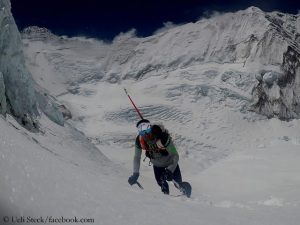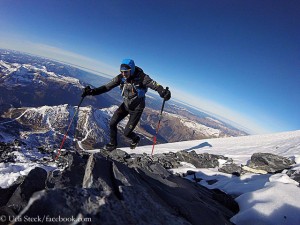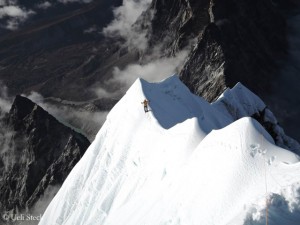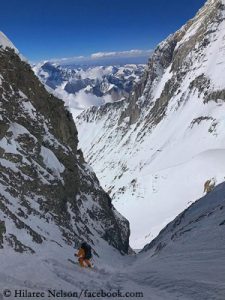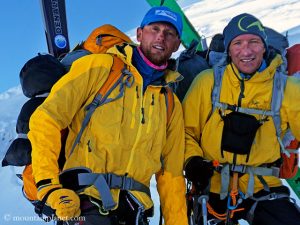On the death of Ueli Steck: One of the best, but not a reckless gambler
Ueli Steck is dead. Fallen to death somewhere on Everest. Incredible. I can not believe it. What has happened? The exact circumstances are not yet clear. The body of the 40-year-old was found somewhere between Camp 1 (at 6,100 m) and 2 (6,400 m). Steck climbed solo on Nuptse, slipped and fell about 1,000 meters deep, reports the Kathmandu-based newspaper “The Himalayan Times”. In the past week, Ueli had reported via Facebook on a “quick day” climbing from Base Camp up to 7,000 meters and back again. The attached photo showed him with trailrunning shoes. Typical Ueli, I twittered with a twinkle in my eye – and the thought: Only one like him gets away with this, “The Swiss Machine”, the “Speedy Gonzales” among the high-altitude climbers, undisputedly one of the best.
Accepting risk
I’ve often met Ueli or phoned him. He did not shy away from the risk, but he was not a reckless gambler. So his probably biggest coup, the solo climb via the Annapurna South Face in fall 2013, had even driven him into a deep personal crisis. He felt that he had overtightened the screw with this project because he had not really been able to control the hazards. Risk management was a topic he was dealing with. “When we climb mountains we try to take good decisions and not to run too much risk. In the end, however, we just have to make it clear that once we go to the mountains, no matter on what level, we risk an accident”, Ueli once told me. “For me, it’s only either black or white. Either I just accept it or not. If I don’t accept it, I can’t go to the mountains. But climbing and all the experiences when I do it are simply too important for me and give me too much. Therefore I accept the risk.“
“My dream“
Five weeks ago, before Ueli left for Nepal, we talked to each other. He was looking forward to returning to Mount Everest. He had checked off his traumatic experience there in spring 2013 – the attack of a Sherpa mob in high camp against him, Simone Moro and Jonathan Griffith. He looked forward optimistically. His project, the Everest-Lhotse traverse was ambitious, just typical Ueli: via the rarely climbed West Ridge and the Hornbein Couloir to the summit, then down to the South Col and (via the variant opened in 2010 by the native Kazakh Denis Urubko) to the 8,611-meter-high summit of Lhotse – as always on his eight-thousander projects without supplemental oxygen. “That would be my dream,” said Ueli, still a realist: “There must be perfect conditions and the weather must be good and stable. I think it’s important to have ideas, but in the end you have to decide on the mountain what is possible and impossible.”
On the same wavelenght
We agreed to talk to each other again if he would have completed his acclimatization phase on Everest. Now we will never again do it, neither about his projects and dreams nor about anything else. That makes me sad. Not only because he was a great climber, but also because I felt we were tuned to the same wavelength. Ueli will be missing, my thoughts are with his wife Nicole and his family.
“People say, a cat has nine lives. How many lives do you have?” I once asked Ueli. He took the time to answer: “Oh, how many lives? I have already been very lucky a few times. But I don’t count these experiences because that makes you just crazy.”




